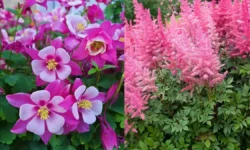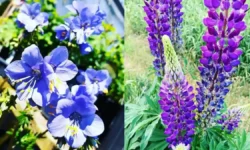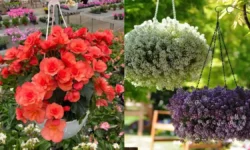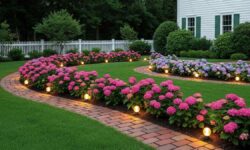Here’s my honest, big-hearted guide to annual flowers that attract hummingbirds—written like we’re chatting on the porch, coffee in hand, watching those tiny jet-fueled birds zip past. I’ve pulled insights from trusted roundups and blended them with hands-on tips that make a backyard actually hum (literally). In short: if you want a summer with constant color and frequent fly-bys, annual flowers that attract hummingbirds give you the fastest, most flexible results. I’ll walk through varieties, identification clues, USDA zones (how they’re treated across climates), color palettes, sun and soil needs, plus little tricks that made a difference in my own beds and baskets.
Table of Contents
Annual flowers that attract hummingbirds: the fast way to a buzzing summer
If you’re impatient (same), annual flowers that attract hummingbirds deliver instant gratification—lush bouquets of nectar-rich color in weeks, not years. They also let you change the vibe year to year: bold jewel tones this summer, soft pastels next, all while feeding your winged VIPs. Pro tip: plant in layers (groundcover, mid-height, tall accents) and stagger bloom times so something is always “on.” Tubular blooms in saturated reds, magentas, oranges, and purples are standouts, but hummers will happily visit white and lime too as long as the nectar is easy to reach.
Quick design rules for a hummingbird-first bed
- Cluster in drifts of 3–7 plants so birds can sip without wasting energy.
- Mix flower shapes (trumpets, wands, clusters) and heights for a “nectar runway.”
- Containers + baskets = mobile nectar stations near your favorite chair (and camera).
- Keep flowers deadheaded, and refresh potting mix with slow-release fertilizer midseason.
Salvia (annual bedding salvia & tender sages)
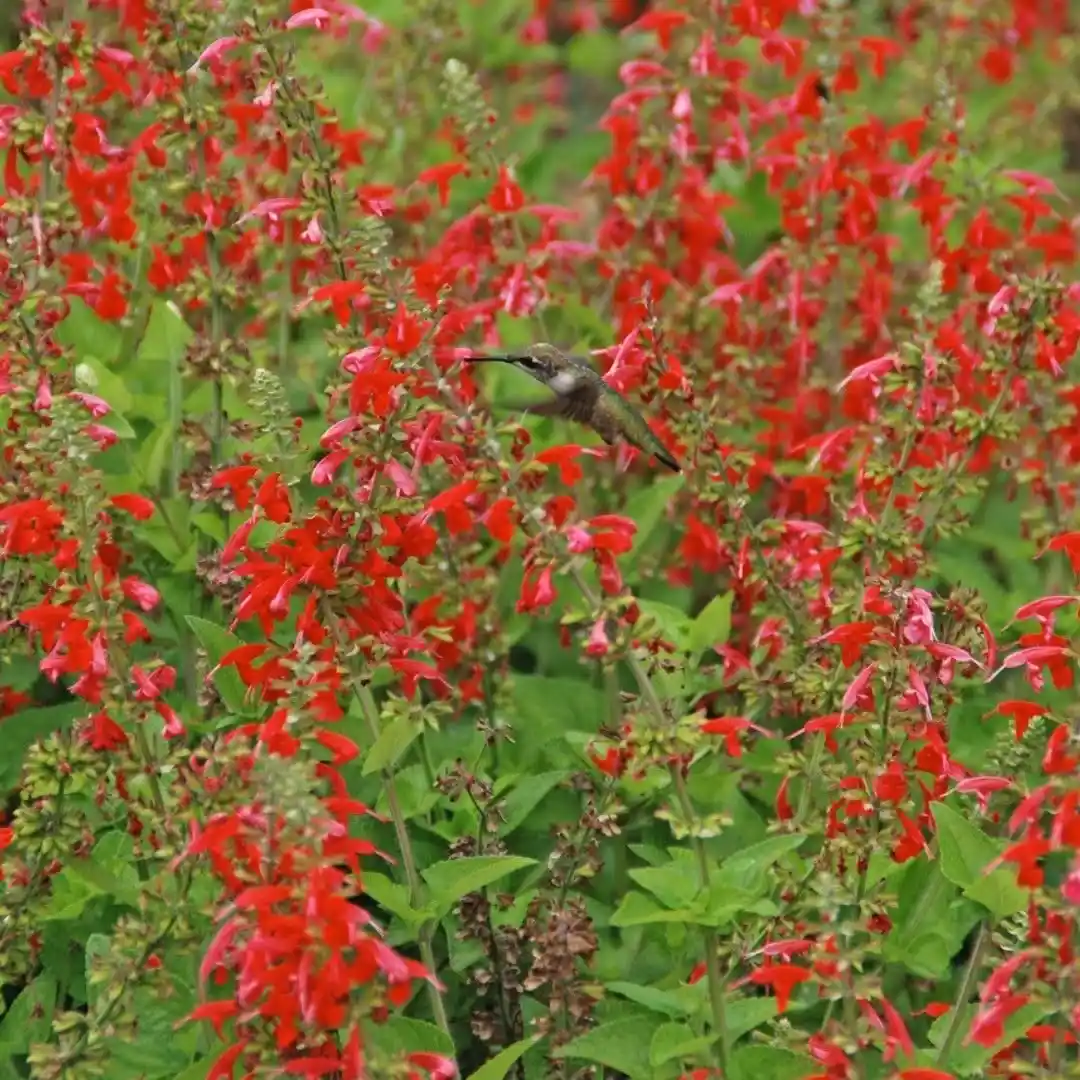
Why it’s a superstar: Hummingbirds treat salvia like a bottomless juice bar. Long wands of tubular florets in red, magenta, purple, or electric blue stand at attention and practically glow at dusk, which is prime fly-time. Among annual flowers that attract hummingbirds, salvia is a cornerstone because it packs nectar into a shape that’s made for a hummer’s bill and tongue.
Characteristics & ID: Classic bedding Salvia splendens gives those tight, colorful spires; tender sages like Salvia guaranitica (‘Black and Blue’) throw dramatic cobalt flowers on ink-blue calyxes. Foliage is typically aromatic, and plants range from compact bedding forms to big, architectural accents.
Zones & type: Usually grown as annuals. Tender perennial in Zones ~8–11 (varies by species).
Sun exposure: Full sun (light afternoon shade in intense heat).
Soil needs: Average, well-drained soil; don’t overwater.
Color varieties: Reds, purples, pinks, blues, bicolors.
Care tips: Deadhead spikes to keep flower production high; pinch young plants once to encourage bushiness. Feed lightly every 2–3 weeks in containers. Salvia is the plant I always double up on when I want annual flowers that attract hummingbirds to feel like a daily show.
Zinnia (cut-flower classic with bonus nectar)
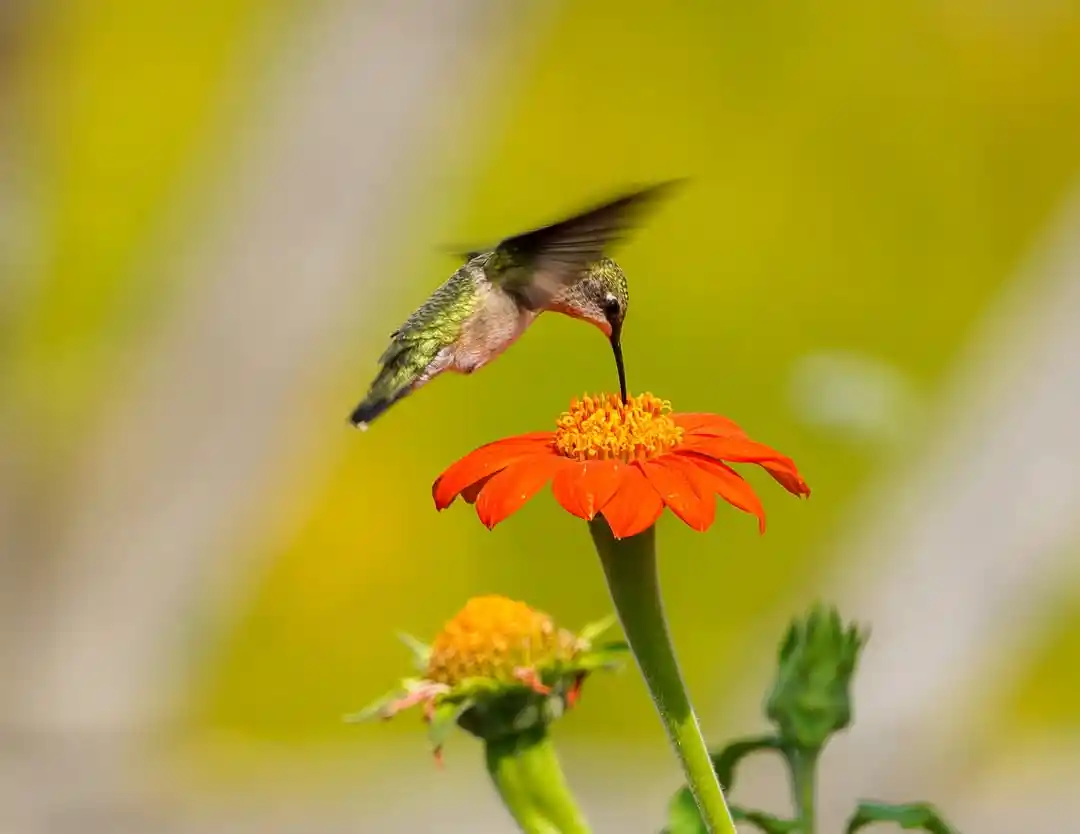
Why it’s loved: Zinnias aren’t tubular, but hummingbirds still make frequent pit-stops, and butterflies pile on for good measure. If you want bright, happy color that keeps giving you bouquets, zinnias are the friend that never flakes.
Characteristics & ID: Daisy to dahlia-style blooms in every cheerful shade—hot pinks, oranges, reds, purples, yellows, whites. Sturdy stems, long blooming, and a tidy habit make them easy to use anywhere you want annual flowers that attract hummingbirds to read “festival.”
Zones & type: True annuals across all zones.
Sun exposure: Full sun.
Soil needs: Lean to average soil with good airflow; avoid heavy nitrogen to prevent leafy, bloom-light plants.
Color varieties: Everything under the sun, including lime and bi-colors.
Care tips: Direct-sow after soil warms; thin to improve airflow; deadhead relentlessly. Powdery mildew can show up, so give them breathing room and water the soil, not the foliage.
Petunia (mounding color for baskets & borders)
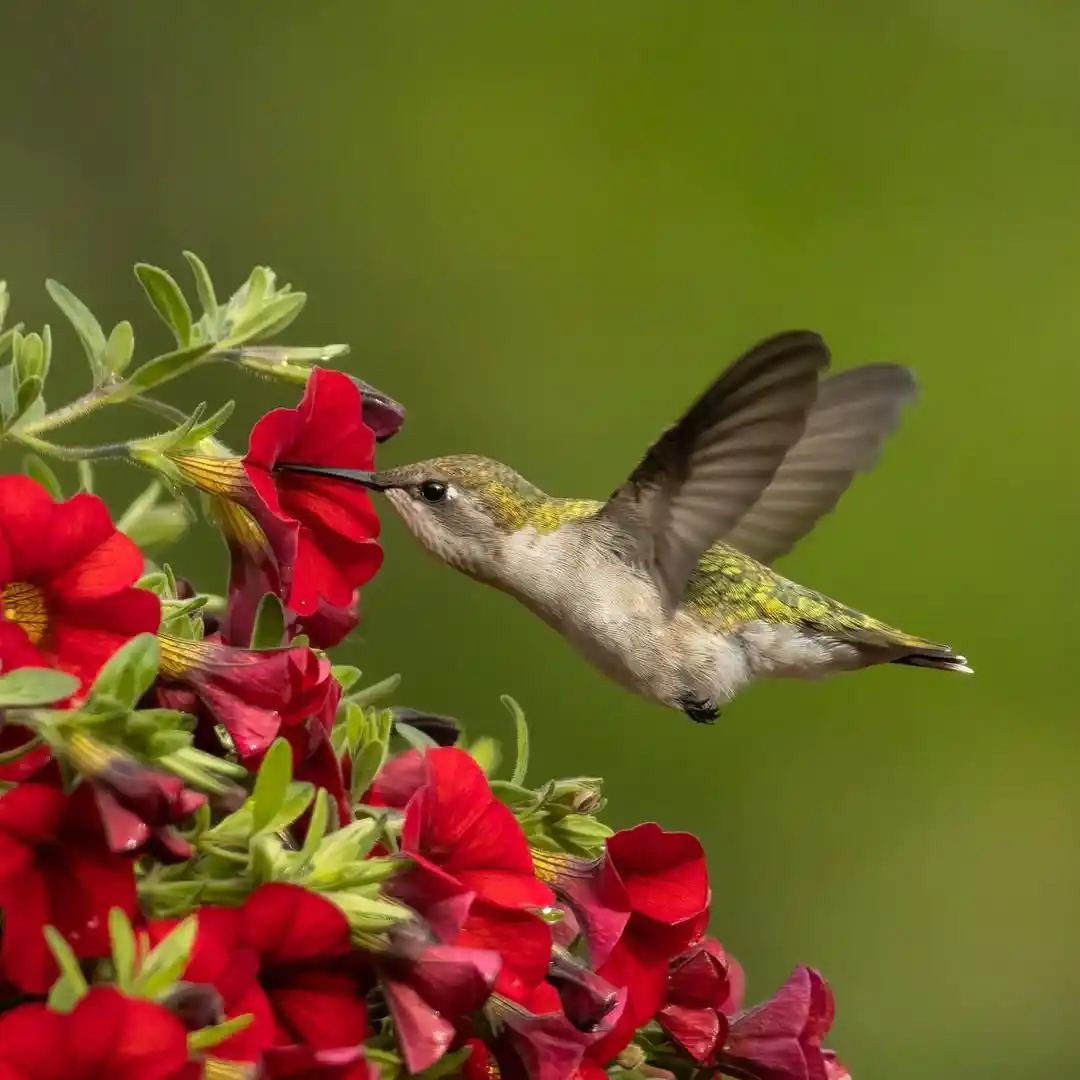
Why it’s beloved: Trumpet-shaped blooms are basically nectar megaphones. Petunias mass beautifully, which creates a visual beacon for hummingbirds. They’re also easy to weave into color stories and spill gorgeously out of baskets.
Characteristics & ID: Mounding or trailing habit, velvety petals, and a scent that’s subtle but sweet in the evening. The tubes are just right for quick sips, and modern series bloom like they have something to prove.
Zones & type: Tender perennial, widely grown as an annual.
Sun exposure: Full sun; morning sun with light afternoon shade in very hot regions.
Soil needs: Rich, well-drained potting mix in containers.
Color varieties: From classic reds and pinks to moody purples, stripes, and veining.
Care tips: Many series are self-cleaning, but a midseason haircut revives them. Feed regularly; heavy bloomers are hungry. I pepper petunias between taller annual flowers that attract hummingbirds to make a soft, nectar-rich carpet.
Fuchsia (pendulous nectar cups for shady hangouts)

Why it’s magic: For bright shade and porch edges, fuchsia is a neon “OPEN” sign for hummingbirds. Those two-tone bells dangle like jewelry, and the nectar is easy access from below.
Characteristics & ID: Pendant blossoms in rich pinks, purples, reds, and whites. Some cultivars have a sophisticated, almost old-world look; others are playful and bold. Trailing types are perfect for hanging baskets; upright forms suit patio containers.
Zones & type: Tender perennial, grown as an annual in most climates.
Sun exposure: Bright shade to partial sun—morning sun, afternoon shade is ideal.
Soil needs: Even moisture, sharp drainage in a peat-free mix; steady light feeding.
Color varieties: Many bicolors with contrasting sepals and petals.
Care tips: Protect from blazing heat, prune lightly to keep a fresh cascade, and keep water consistent. Among annual flowers that attract hummingbirds in shade, fuchsia is the headliner.
Lantana (heatproof clusters for sun-baked spots)
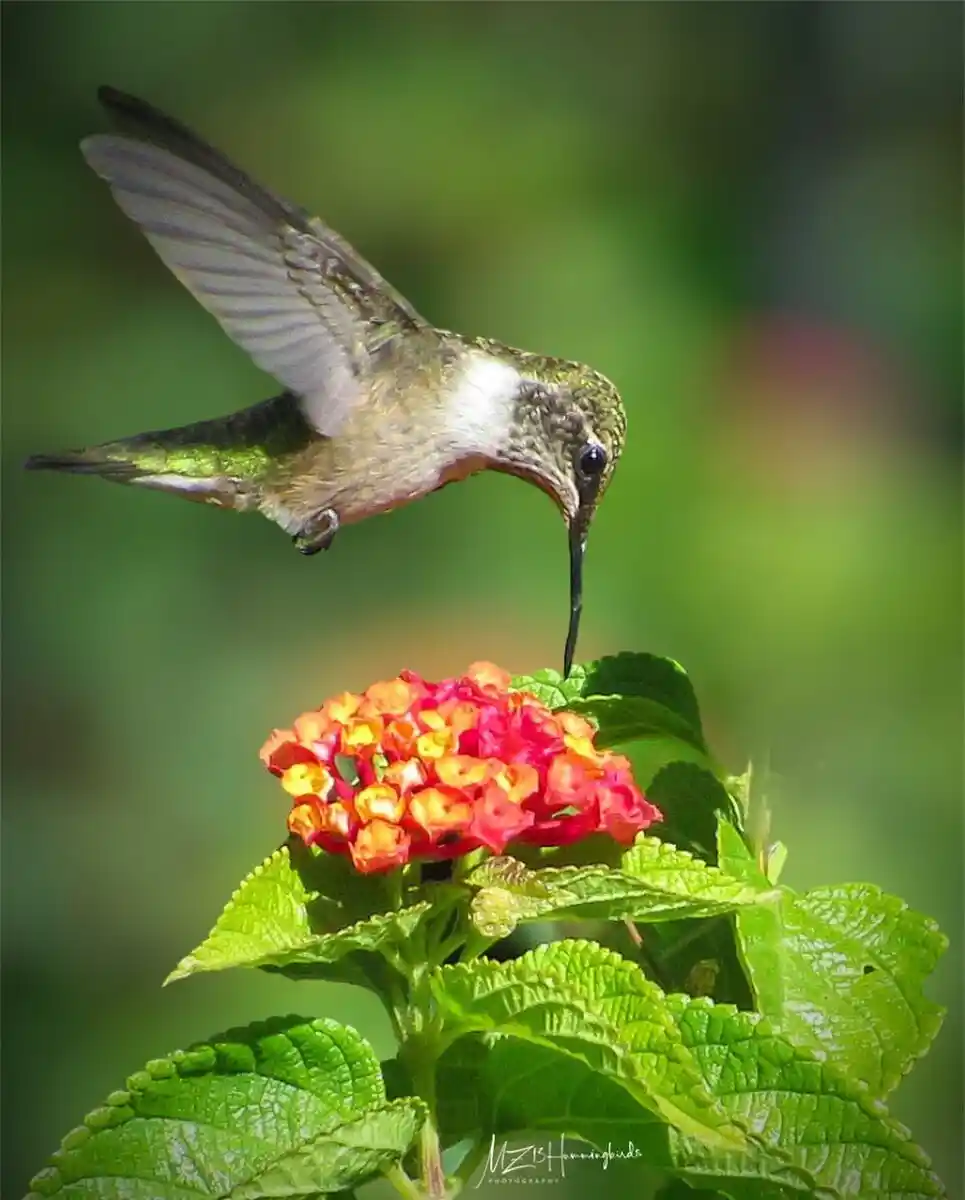
Why it’s on the list: Lantana thrives where other annuals tap out—baking sun, lean soil, forgetful watering schedules. Hummingbirds love the clustered, tubular florets, and the color-changing umbels are a bonus for the human eye.
Characteristics & ID: Rounded clusters that can shift hues as blooms age (think yellow to orange to red). Slightly rough, aromatic foliage and a tidy mound to small-shrub habit.
Zones & type: Perennial in warm zones (roughly 8–11), annual elsewhere.
Sun exposure: Full sun, heat champion.
Soil needs: Average to sandy, well-drained soil; drought tolerant once established.
Color varieties: Golds, oranges, reds, pinks, purples, multicolors.
Care tips: Avoid heavy feeding; too much nitrogen means fewer flowers. Trim lightly to keep shape and push new clusters. In a sun-scorched bed of annual flowers that attract hummingbirds, lantana is your anchor.
Nasturtium (edible petals, spicy perfume, eager blooms)
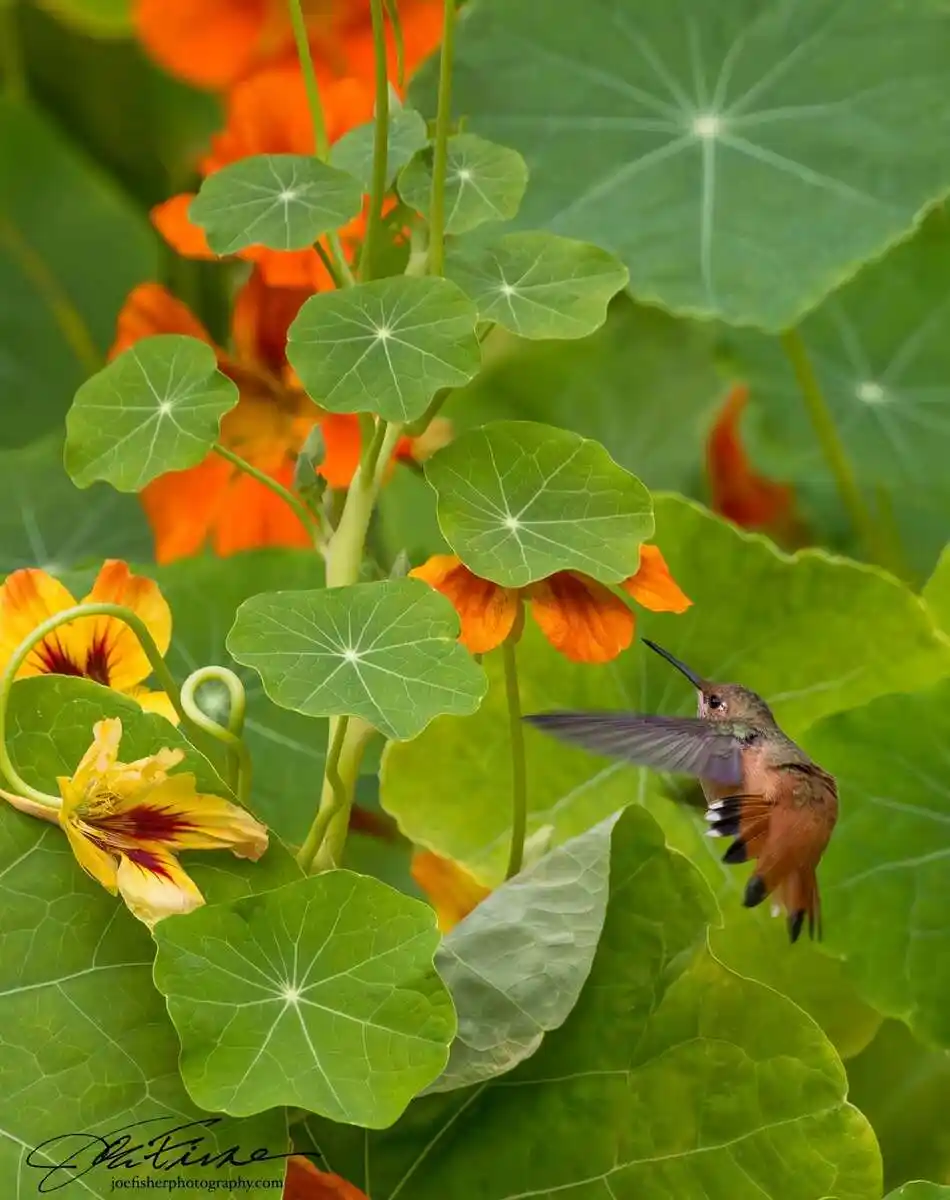
Why you’ll love it: Nasturtiums are cheerful, edible, and wildly forgiving. The funnel-like flowers have nectar spurs that hummers zip into, and you get peppery leaves and petals for salads.
Characteristics & ID: Round, shield-like leaves; bright orange, red, and yellow blooms with a distinctive spur. Trailing types are perfect for spilling over walls and basket rims; mounding types are tidy in border fronts.
Zones & type: Annual almost everywhere; some reseed.
Sun exposure: Full sun; appreciates afternoon shade in extreme heat.
Soil needs: Lean, well-drained soil—too rich, and you’ll get leaves over flowers.
Color varieties: Warm brights and softer apricots; singles and doubles.
Care tips: Direct-sow; avoid overfeeding; harvest flowers and leaves often. As annual hummingbird flowers, nasturtiums are joyful fillers that also feed you.
Lobelia (sky-blue drifts and tidy edges)

Why it’s handy: Cool-loving lobelia gives you that vivid blue so many gardens lack. The petite trumpets create a gentle edge and a soft spill that hummingbirds will cruise during morning rounds.
Characteristics & ID: Lobelia erinus makes trailing mounds peppered with small trumpets in blue, violet, white, or pink. It’s the “softening” plant that makes containers look finished.
Zones & type: Treated as an annual in most places.
Sun exposure: Morning sun with afternoon shade in hot regions.
Soil needs: Even moisture and good drainage; dries out quickly in small pots.
Color varieties: Blues are iconic; whites and pinks brighten shade.
Care tips: Shear midseason for a second flush. In a mixed display of annual flowers that attract hummingbirds, lobelia is the calm, cooling color that frames your stars.
Impatiens (color in shade where feeders get action)
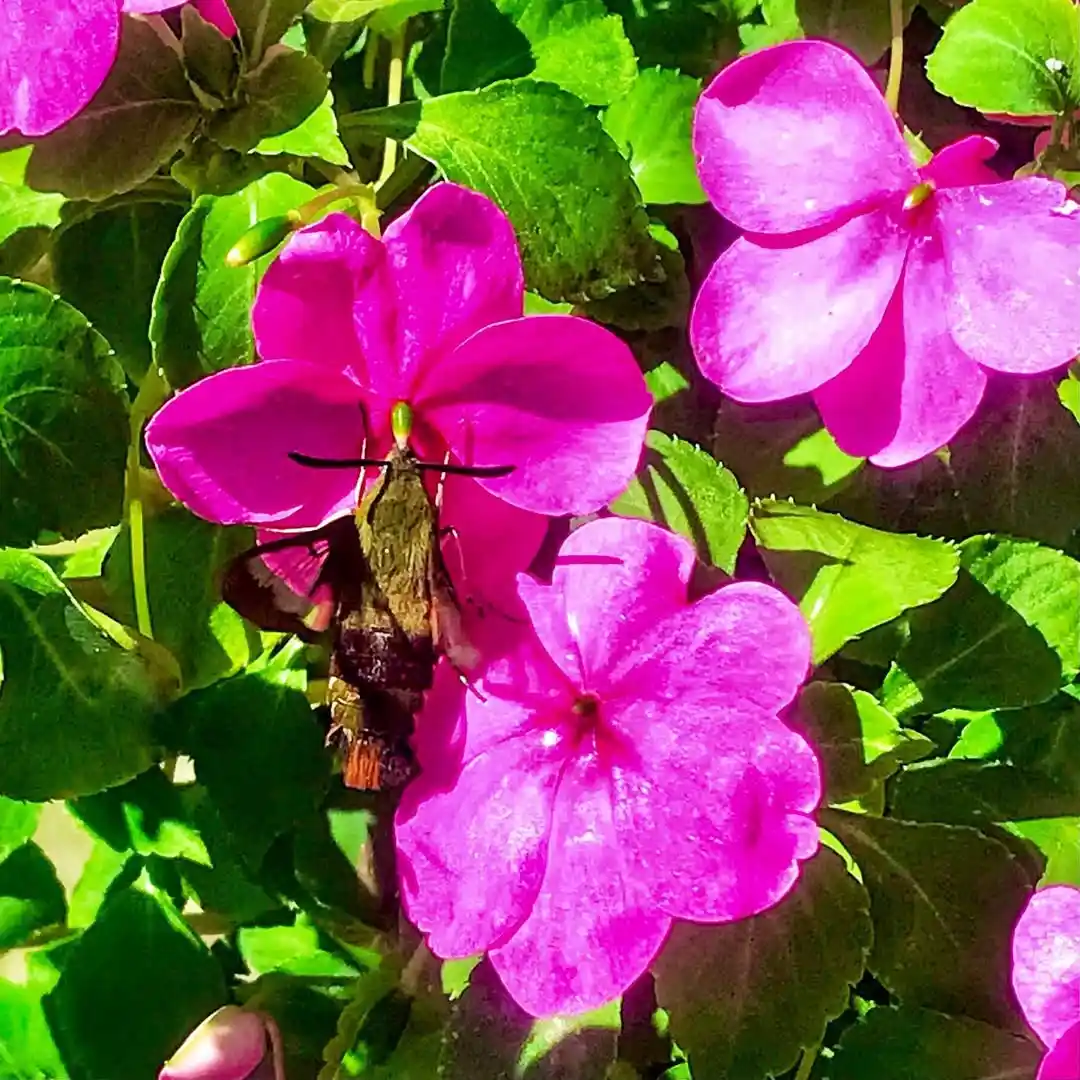
Why it earns a spot: Shade beds deserve hummingbird traffic, too. Impatiens provide bold color masses near porches—perfect locations to pair with feeders so birds can sip flowers between nectar top-offs.
Characteristics & ID: Rounded petals in candy-store colors. Compact, mounding form that reads lush and “finished” fast.
Zones & type: Tender perennial; grown as annual in most climates.
Sun exposure: Bright shade to dappled light.
Soil needs: Rich, moisture-retentive but well-drained media.
Color varieties: Reds, corals, pinks, violets, whites, and bicolors.
Care tips: Keep evenly moist, feed lightly, give airflow, and choose downy mildew–resistant series where needed. For annual flowers that attract hummingbirds in shade, impatiens are dependable crowd-pleasers.
Cosmos (airy, meadowy motion the birds don’t mind)

Why it helps: Cosmos adds height and breezy movement to your hummingbird garden. While not strongly tubular, the open nectar keeps wing traffic active, especially when mixed with spiky salvias and cuphea.
Characteristics & ID: Feathery foliage with daisylike blooms—pink, white, magenta (C. bipinnatus) and glowing oranges (C. sulphureus). Tall, willowy stems that sway in the slightest wind.
Zones & type: True annuals.
Sun exposure: Full sun.
Soil needs: Lean to average soils; minimal fertilizer.
Color varieties: From delicate pastels to fiery oranges.
Care tips: Direct-sow easily; deadhead to stretch bloom; stake tall types if wind-prone. Cosmos is the breezy counterpoint that makes structured annual flowers that attract hummingbirds feel alive and dynamic.
Cuphea (cigar plant & bat-faced cuphea)
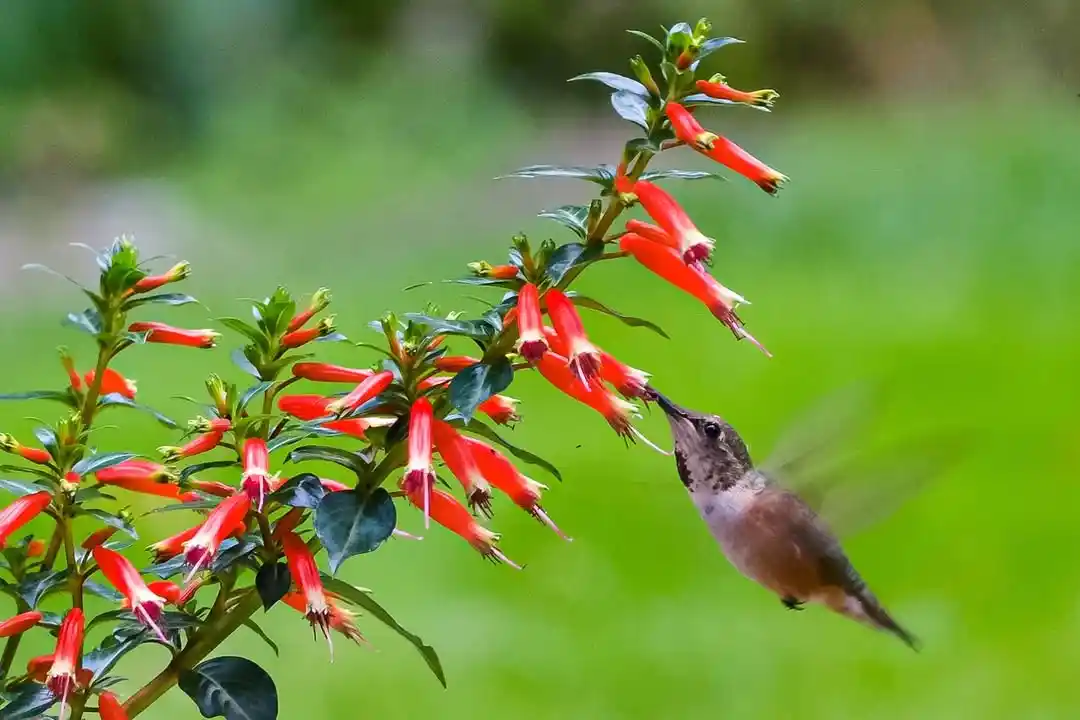
Why hummers are obsessed: Small, tubular blossoms produced in huge numbers—like tiny nectar taps set to “on.” Cuphea thrives in containers and sunny borders, making it a set-and-forget workhorse.
Characteristics & ID: Cuphea ignea (cigar plant) has orange-red tubes; C. llavea (bat-faced) shows a bright “face” with dark ears—adorable and oddly dramatic. Foliage is tidy, plants mound gracefully.
Zones & type: Tender perennial in warm zones; annual in cooler climates.
Sun exposure: Full sun to light shade.
Soil needs: Well-drained, average soil; moderate watering.
Color varieties: Oranges, reds, purples with fun contrasts.
Care tips: Minimal deadheading (many self-clean); trim lightly if leggy. For continuous, high-traffic annual flowers that attract hummingbirds, cuphea belongs in every container recipe.
Agastache (a.k.a. hummingbird mint, often used as annual color)
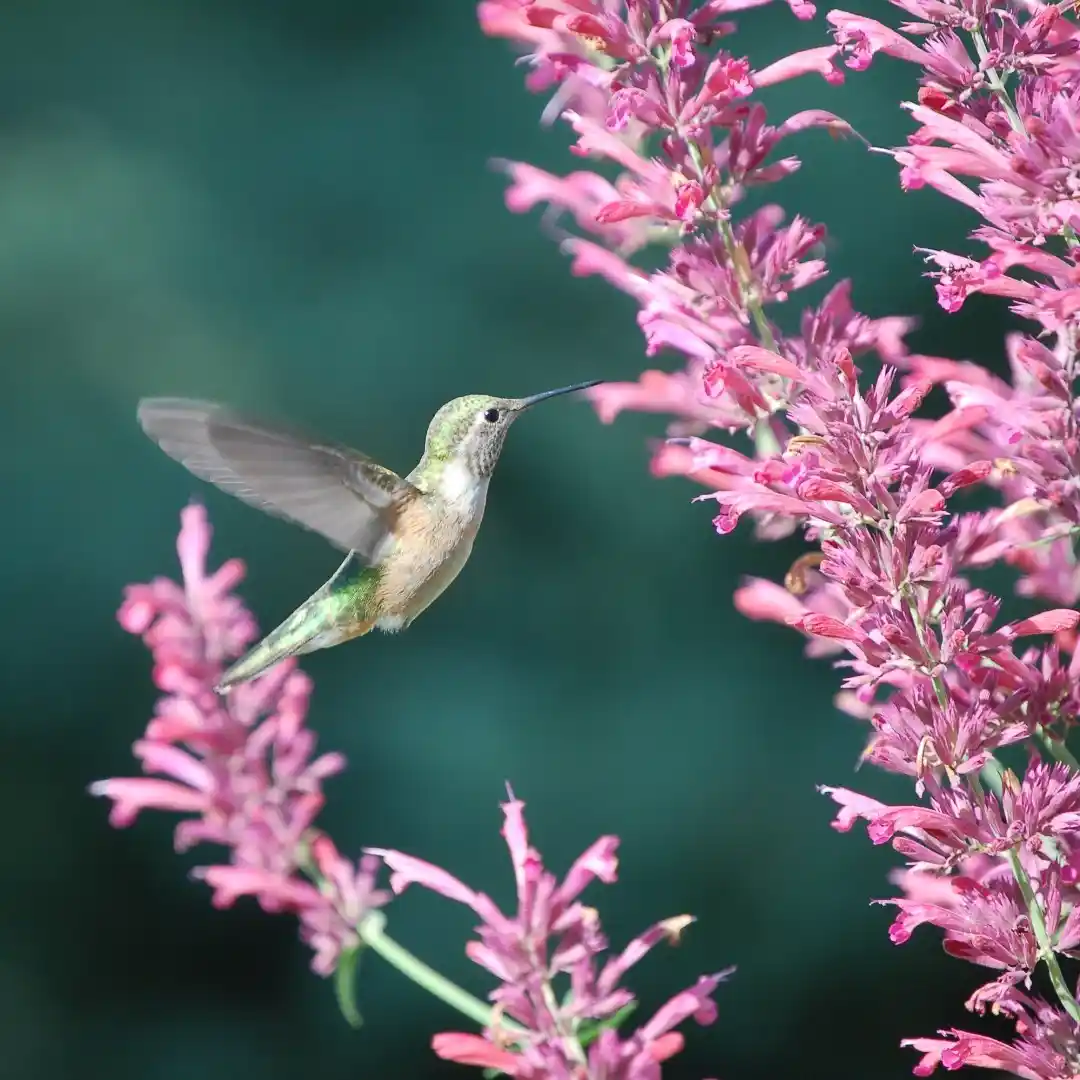
Why it earns a “maybe-annual” pass: Some agastache are perennial, but many gardeners treat showy hybrids as one-season color spikes. The aromatic foliage is a bonus; brush against it and the minty, anise notes are instant summer.
Characteristics & ID: Vertical wands packed with tubular florets in apricot, melon, coral, magenta, and lavender. Hummingbirds hover from bottom to top like they’re scanning a barcode of nectar.
Zones & type: Varies by species; often used as annual in cool climates.
Sun exposure: Full sun.
Soil needs: Excellent drainage; lean soils preferred.
Color varieties: Warm sherbets to electric cools.
Care tips: Don’t overwater; pinch lightly to encourage branching. Agastache is a natural “thriller” among annual flowers that attract hummingbirds, adding height and fragrance without fuss.
Verbena (sun-loving clusters that drip from baskets)
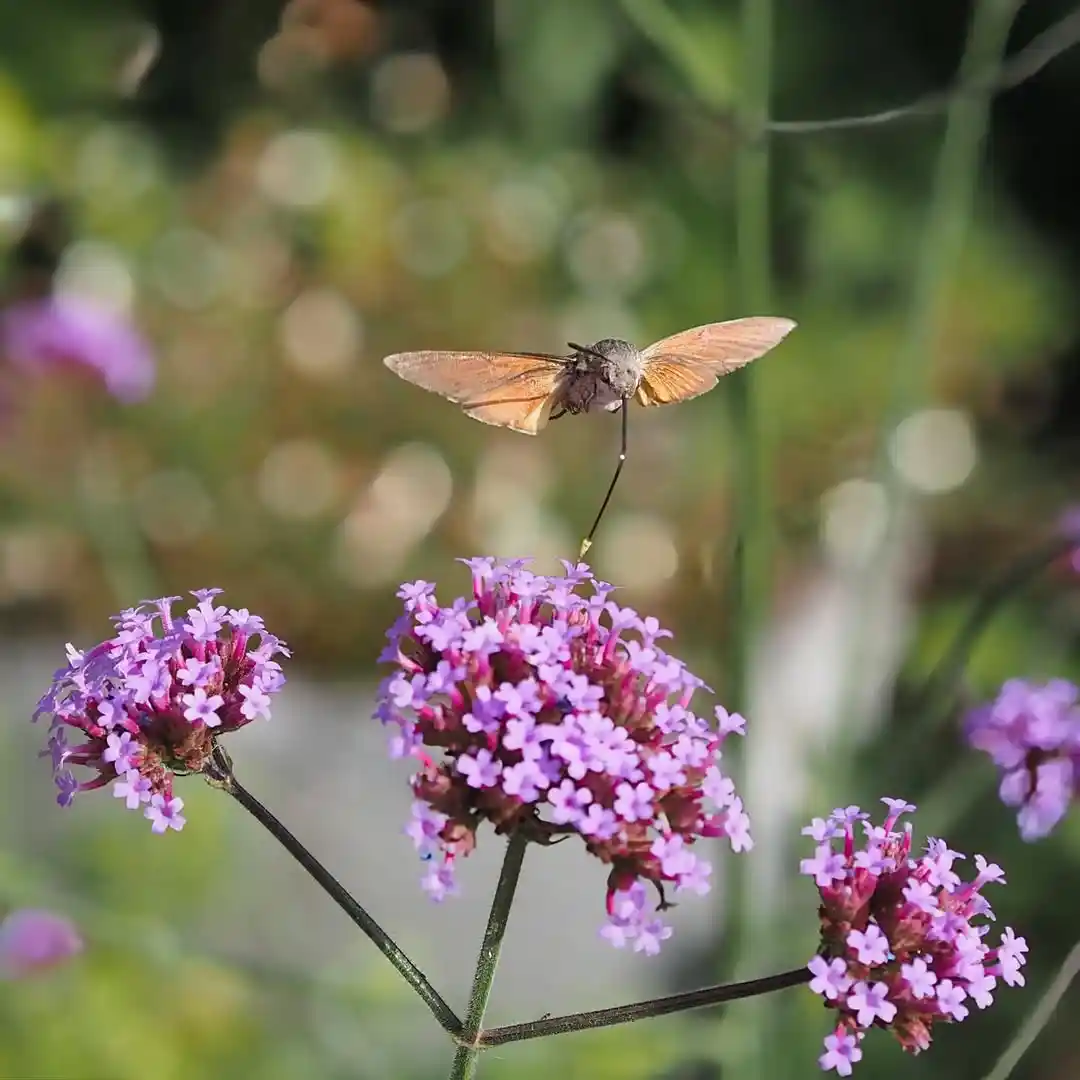
Why it’s a staple: Verbena throws nonstop clustered blooms, each cluster hiding dozens of petite tubes. It’s one of the easiest ways to turn planters into hummingbird snack bars.
Characteristics & ID: Trailing or mounding, with dense clusters in reds, magentas, purples, and whites. Looks especially lush when allowed to spill over edges.
Zones & type: Annual in most zones; some forms perennial in warm climates.
Sun exposure: Full sun.
Soil needs: Sharp drainage; don’t let pots sit in saucers of water.
Color varieties: Saturated jewel tones and fresh brights.
Care tips: Light feeding every 2–3 weeks; trim by a third midseason to refresh. In a matrix of annual flowers that attract hummingbirds, verbena is your dependable spiller.
Nicotiana (flowering tobacco with night perfume)
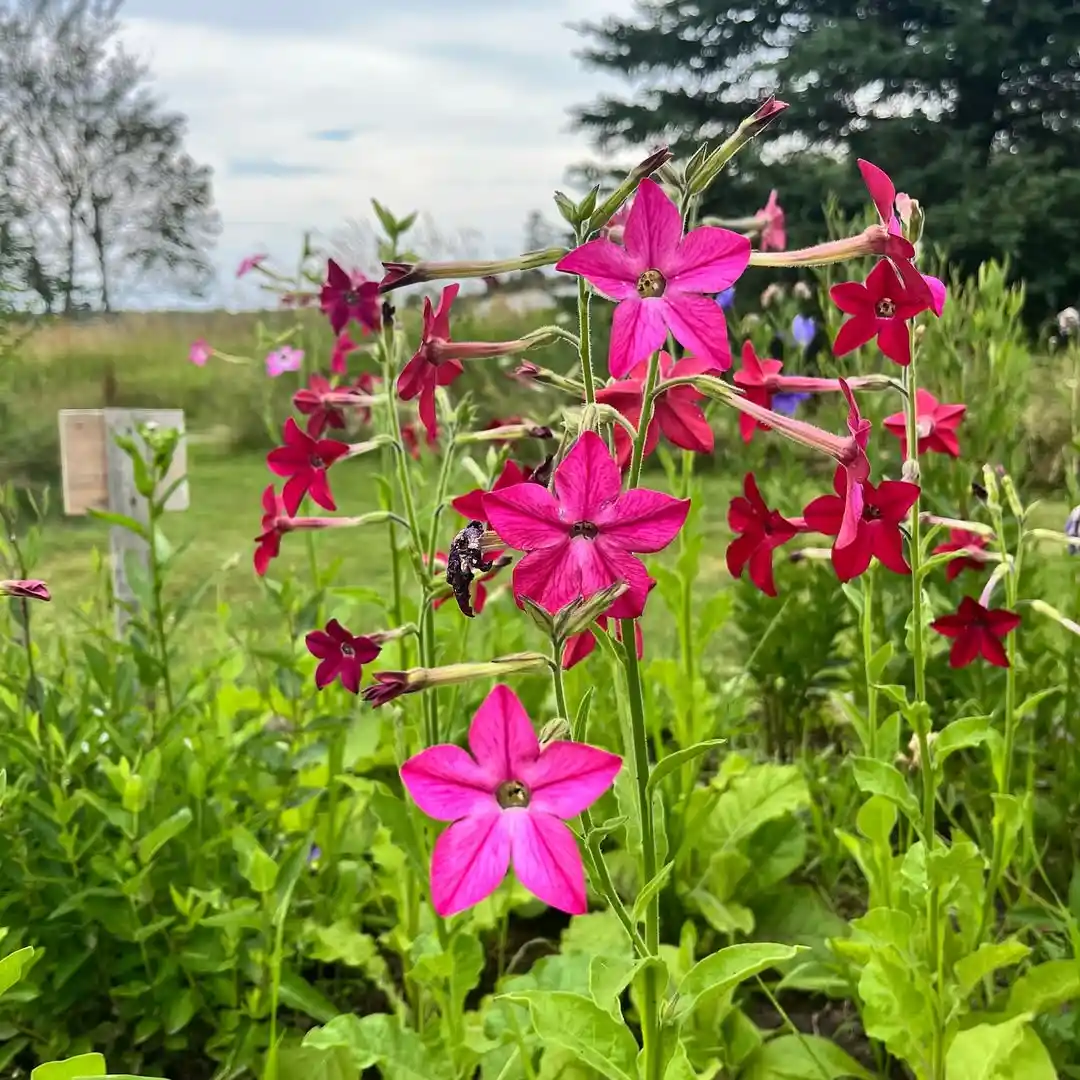
Why it’s different: Nicotiana’s long, slender tubes open into starry faces and perfume the evening. Hummingbirds will happily sip during morning and late-day rounds.
Characteristics & ID: Upright stems with clusters of star-shaped blooms—white, lime, pink, red—often lightly sticky foliage (normal!). Taller varieties create elegant vertical accents.
Zones & type: Annual in most regions; some reseed.
Sun exposure: Full sun to part shade.
Soil needs: Average, well-drained soil; consistent moisture.
Color varieties: From ethereal lime and white to hot pink and red.
Care tips: Deadhead fading clusters; provide stakes for the tallest forms if windswept. Nicotiana adds that evening romance to a garden of annual flowers that attract hummingbirds.
Cardinal flower (Lobelia cardinalis, often used like an annual in cool zones)

Why include it: Technically perennial, but commonly used for one-season drama in containers or where winters are harsh. The saturated scarlet is nearly impossible for hummingbirds to ignore.
Characteristics & ID: Bold red spikes on upright stems; glossy green leaves; architectural presence that reads “garden designed with intention.”
Zones & type: Perennial Zones 3–9; seasonal accent elsewhere.
Sun exposure: Sun to part shade.
Soil needs: Prefers consistently moist soil—more moisture-tolerant than most.
Color varieties: Red is classic; select cultivars for deeper or slightly varied tones.
Care tips: Keep evenly moist; pair with water features or low spots. Among annual flowers that attract hummingbirds used in pots, cardinal flower is a knockout thriller.
Bee balm (Monarda didyma, perennial often used as a one-season anchor)
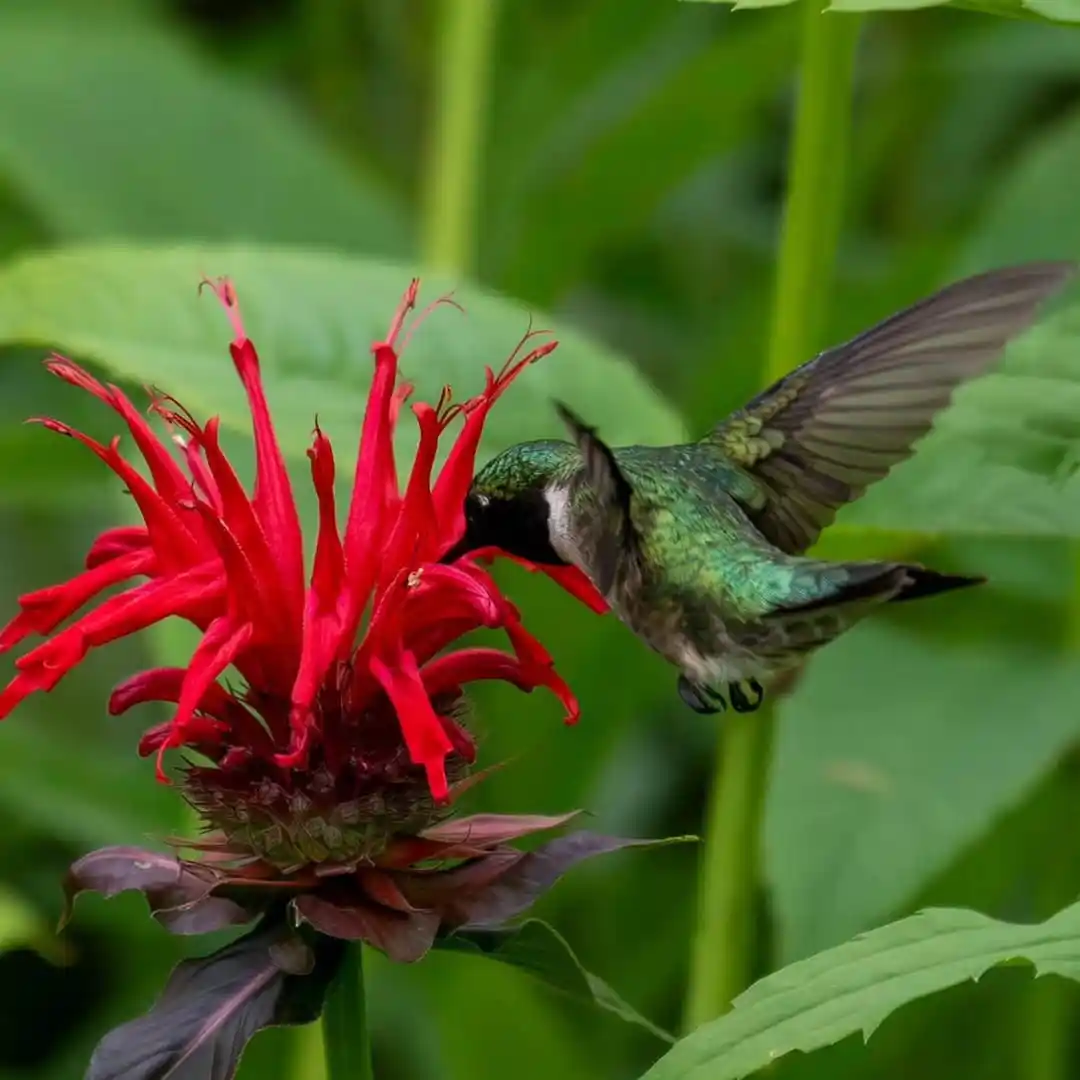
Why it belongs here: Another technical perennial that acts like an annual accent in many designs, thanks to those shaggy firework blooms. Nectar is abundant, and hummers don’t hesitate.
Characteristics & ID: Bright whorls of tubular petals in red, pink, magenta, and purple. The blooms have wild, celebratory energy, like a sparkler frozen mid-burst.
Zones & type: Perennial Zones 4–9; seasonal showpiece in containers beyond that.
Sun exposure: Sun to part shade.
Soil needs: Rich, evenly moist soil; good airflow to discourage powdery mildew.
Color varieties: Classic scarlet plus modern magentas and fuchsias.
Care tips: Deadhead to tidy; divide clumps every few years if you keep it as a perennial. For a pot-and-patio set of annual flowers that attract hummingbirds, bee balm provides that riot of color that photographs beautifully.
Black & Blue sage (Salvia guaranitica ‘Black and Blue’)

Why it’s a head-turner: Deep blue flowers against inky-black calyxes—pure drama. If you want backyard theater, this is your leading actor and hummingbirds are your enthusiastic audience.
Characteristics & ID: Tall, arching spikes; vivid cobalt tubes on dusky stems; lush green foliage. Plants can grow large with a handsome, shrubby silhouette.
Zones & type: Tender perennial roughly Zones 8–10; used as an annual elsewhere.
Sun exposure: Full sun to light shade.
Soil needs: Average, well-drained soil; moderate water.
Color varieties: The signature blue-on-black contrast; related cultivars offer similar vibes.
Care tips: Pinch once early for bushier growth; stake if necessary in windy corridors. If there’s one plant that makes annual flowers that attract hummingbirds feel cinematic, it’s this.
Bonus mentions and mix-and-match ideas
Anchor five: Salvia, verbena, petunia, zinnia, and cuphea create a foolproof backbone of annual flowers that attract hummingbirds with long bloom windows and easy care. From there, choose two shade-capable friends (fuchsia, impatiens) and two “heat warriors” (lantana, zinnia again or verbena) to round out the spectrum. If you want one wild-card heart-stealer for containers, add cardinal flower or bee balm and let it steal the scene.
How to combine annual flowers that attract hummingbirds (without overthinking)
Color story: Pick a hero color (red or magenta is classic for hummingbirds), then add one neighbor color (purple or pink) and one light bright (white or lime) for sparkle. For instance: red salvia + purple verbena + white nicotiana.
Structure: Go “thriller–filler–spiller” in containers:
- Thriller: tall salvia or nicotiana
- Filler: mounding zinnias or petunias
- Spiller: verbena or lobelia
Bloom relay: Early (lobelia, petunias), mid (zinnias, verbena), late (agastache, cuphea) to create a season-long chain of annual flowers that attract hummingbirds that never leaves gaps.
Water rhythm: Hummers return predictably when beds stay hydrated and floral. Keep pots evenly moist, especially in heat waves.
Micro-habits that made the biggest difference for me
- Plant in multiples. A single cuphea is cute; three in a triangle become a nectar station. This rule elevated my annual flowers that attract hummingbirds from “oh nice” to “whoa.”
- Deadhead weekly. Five minutes, one bucket, huge payoff—more buds open sooner. If I skip a week, the show dims.
- Feed lightly, consistently. Half-strength liquid feed every 10–14 days in containers keeps color surging without the floppy, leafy growth that heavy nitrogen causes.
- Morning sun beats harsh afternoons. In blistering heat, shift some baskets to gentle morning light and bright shade during the hottest hours. Shade-friendly annuals (fuchsia, lobelia, impatiens) appreciate that nuance.
- Pair with water. A tiny bubbler or dripper nearby turns your flower patch into a hummingbird lounge. I swear they queue up like regulars at a café.
Sun exposure and soil quick guide (by plant)
- Salvia (annual/tender) – Full sun; average, well-drained soil.
- Zinnia – Full sun; lean to average soil; good airflow.
- Petunia – Full sun; rich mix in pots; steady feed.
- Fuchsia – Bright shade/partial sun; even moisture; good drainage (great for baskets).
- Lantana – Full sun; heat/drought tolerant; don’t overfertilize.
- Nasturtium – Full sun; lean soil; minimal feed.
- Lobelia (annual) – Morning sun/afternoon shade; consistent moisture.
- Impatiens – Bright shade; rich, moist media; airflow.
- Cosmos – Full sun; lean soil; deadhead.
- Cuphea – Full sun to light shade; well-drained; moderate water.
- Agastache – Sun; excellent drainage; lighter feeding.
- Verbena – Sun; sharp drainage; trim midseason.
- Nicotiana – Sun to part shade; average soil; deadhead.
- Cardinal flower – Sun/part shade; prefers constant moisture.
- Bee balm – Sun/part shade; rich soil; airflow to deter mildew.
Putting it all together: a simple 8×4 bed plan
- Back row (tall): 5 salvia (‘Black & Blue’ or red bedding types) + 3 nicotiana.
- Middle row: 5 cuphea + 5 zinnias (alternating).
- Front row: 7 verbena + 7 lobelia.
- Pocket spots: 5 nasturtiums to tumble over edges.
This tiny plot offers a color river of annual flowers that attract hummingbirds with nectar options morning to dusk—and it photographs like a dream.
Maintenance calendar for annual hummingbird flowers
- Late spring: Harden off starts, plant after last frost; mulch lightly.
- Early summer: Deadhead weekly; begin light liquid feed.
- Midsummer: Trim verbena and petunias back by ⅓; top-dress with compost; keep salvia spikes coming.
- Late summer: Fill any gaps with quick-blooming cosmos or another flat of verbena to keep the nectar train running.
- Early fall: Leave some seedheads (zinnia, cosmos) for birds; collect favorite seeds for next year.
FAQs: Annual flowers that attract hummingbirds
1) What are the absolute easiest annual flowers that attract hummingbirds for beginners?
Start with salvia, verbena, and petunias. They’re forgiving, colorful, and bloom for months, so you get reliable traffic fast.
2) Do hummingbirds only go for red flowers?
Nope. Red is high-visibility, but purple, magenta, hot pink, orange, and even white get plenty of fly-ins—as long as blooms are nectar-rich and easy to hover around.
3) Which annuals bloom the longest in containers?
Verbena, petunias, salvia, cuphea, and zinnias are marathon bloomers if you feed lightly and trim midseason.
4) Can I make shade work for hummingbirds?
Yes. Use fuchsia (bright shade) and impatiens, plus morning-sun baskets under eaves. Pair feeders nearby for quick refuels without full sun.
5) Are there annual flowers that attract hummingbirds which also handle serious heat?
Lantana, verbena, and zinnias are heat lovers once established. Lantana in particular shrugs off scorching afternoons.
6) What’s the best soil for these annuals?
Most prefer well-drained, average soil (containers: quality potting mix). Avoid overfeeding; too much nitrogen makes leaves at the expense of flowers—especially on zinnias and cosmos.
7) Is there a single hanging basket recipe that’s basically cheating?
Yep: fuchsia + trailing verbena + lobelia. The contrast and nectar access turn a quiet porch into a hummingbird runway.
8) Do I need to deadhead all of them?
Deadheading helps nearly all annual flowers that attract hummingbirds, though many modern petunias self-clean. Trimming verbena midseason is a reliable refresh button.
9) Which annuals pair best with a feeder?
Position feeders near salvia, cuphea, and petunias—birds will sample blooms between sips.
10) Can I still include bee balm and cardinal flower if they’re technically perennials?
Absolutely—use them as “one-season anchors” in pots or cool climates for drama. Their nectar value and color are off the charts.
11) What if I only have a sunny balcony?
Do pots of salvia + verbena + zinnias, and tuck in a small cuphea. You’ll have a tidy, high-nectar trio of annual flowers that attract hummingbirds that thrives in containers.
12) Any low-effort options for someone who forgets to water?
Lantana and zinnias are sturdy friends in full sun with occasional neglect—just give them decent drainage and mulch the top of pots to stretch moisture.
13) What colors should I prioritize if I’m going minimal?
Start with red or magenta for signal value, then add purple for depth. That combo pops from across the yard and sits right in the sweet spot for annual flowers that attract hummingbirds.
14) How do I keep blooms going into fall?
Deadhead weekly, trim midseason, and slot in a fresh flat of verbena or cosmos late summer. Keep watering consistent when heat spikes taper off.
15) Can I seed any of these directly in the ground?
Yes—cosmos, nasturtium, and zinnias are friendly to direct-sowing once soil warms. That makes them budget-friendly annual flowers that attract hummingbirds for large drifts.
If you want, tell me your USDA zone, sun pattern, and favorite color palette. I’ll tailor a planting list of annual flowers that attract hummingbirds (plus one optional perennial “ringer”) that fits your space and the vibe you love.

